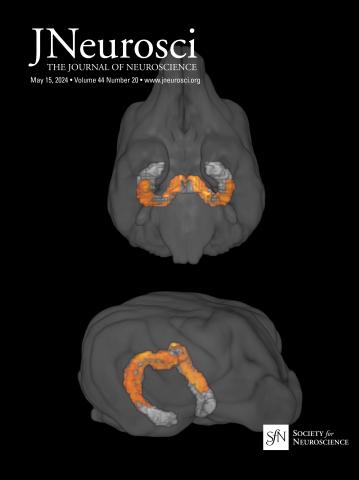Infralimbic projections to the substantia innominata-ventral pallidum constrain defensive behavior during extinction learning.
IF 4.4
2区 医学
Q1 NEUROSCIENCES
引用次数: 0
Abstract
Fear extinction is critical for decreasing fear responses to a stimulus that no longer poses a threat. While it is known that the infralimbic region (IL) of the medial prefrontal cortex mediates retrieval of an extinction memory through projections to the basolateral amygdala (BLA), IL pathways contributing to extinction learning are not well-understood. Given the dense projection from the IL to the substantia innominata-ventral pallidum (SI/VP), an area that processes aversive and appetitive cues, we compared how the IL-SI/VP functions in extinction compared to the IL-BLA pathway in male mice. Using retrograde tracing, we demonstrate that IL projections to the SI/VP originate from superficial (L2/3) and deep cortical layers (L5), and that they are denser than IL projections to the BLA. Next, combining retrograde tracing with labeling for the immediate early gene cFos, we show increased activity of L5 IL-SI/VP output during extinction learning and increased activity of L2/3 IL-BLA output during extinction retrieval. Then, using in vitro recordings, we demonstrate that neurons in the IL-SI/VP pathway are more excitable during extinction learning than retrieval. Finally, using optogenetics we inactivate the IL-SI/VP pathway, and show that this increases defensive freezing during extinction learning and re-extinction, without affecting memory. Taken together, we demonstrate that the IL-SI/VP pathway is active during extinction learning, when it constrains the defensive freezing response. We propose that the IL acts as a switchboard operator, increasing IL L5 communication with the SI/VP during extinction learning, and IL L2/3 communication with the BLA during extinction retrieval.Significance Statement Fear extinction is a widely used behavioral approach to decrease conditioned fear, and projections from the infralimbic cortex to the amygdala are known to mediate extinction memory retrieval. However, less is known about the role of infralimbic pathways in extinction learning. We use neuroanatomical tracing, behavior, slice recordings, and circuit manipulation to show that infralimbic output to the substantia innominata-ventral pallidum, a region that processes aversive and appetitive stimuli, is denser than to the amygdala, and is more active during extinction learning than retrieval, when it acts to constrain the defensive freezing response. Thus, we posit that during extinction the infralimbic uses several lines of communication, one with the substantia innominata-ventral pallidum during learning one with the amygdala during retrieval.在灭绝学习过程中,脑皮层下的突起限制了防御行为。
消除恐惧对于减少对不再构成威胁的刺激的恐惧反应至关重要。虽然已知内侧前额叶皮层的边缘下区域(IL)通过投射到基底外侧杏仁核(BLA)介导消退记忆的检索,但IL参与消退学习的途径尚未得到很好的理解。考虑到从IL到处理厌恶和食欲线索的无名质-腹侧苍白质(SI/VP)的密集投影,我们比较了IL-SI/VP在雄性小鼠中与IL- bla途径相比在灭绝中的功能。通过逆行追踪,我们证明了到SI/VP的IL投射来自皮层浅层(L2/3)和深层(L5),并且它们比到BLA的IL投射更密集。接下来,将逆行追踪与直接早期基因cFos的标记相结合,我们发现在灭绝学习期间L5 IL-SI/VP输出活性增加,在灭绝检索期间L2/3 IL-BLA输出活性增加。然后,通过体外记录,我们证明了IL-SI/VP通路中的神经元在消失学习过程中比恢复过程更容易兴奋。最后,利用光遗传学,我们灭活了IL-SI/VP通路,并表明这增加了在灭绝学习和再灭绝过程中的防御冻结,而不影响记忆。综上所述,我们证明了IL-SI/VP通路在灭绝学习过程中是活跃的,当它限制防御性冻结反应时。我们提出IL充当总机操作员,在消光学习期间增加IL L5与SI/VP的通信,在消光检索期间增加IL L2/3与BLA的通信。恐惧消退是一种被广泛应用于减少条件恐惧的行为方法,从边缘下皮层到杏仁核的投射被认为介导消退记忆的恢复。然而,人们对边缘下通路在灭绝学习中的作用知之甚少。我们使用神经解剖学追踪、行为、切片记录和电路操作来显示,边缘下输出到处理厌恶和食欲刺激的脑白质-腹侧白质的输出比杏仁核更密集,并且在消退学习过程中比恢复过程更活跃,当它抑制防御性冻结反应时。因此,我们假设,在记忆消失过程中,边缘下使用了几条通信线路,一条是在学习过程中与突起物质-腹侧苍白体通信,另一条是在检索过程中与杏仁核通信。
本文章由计算机程序翻译,如有差异,请以英文原文为准。
求助全文
约1分钟内获得全文
求助全文
来源期刊

Journal of Neuroscience
医学-神经科学
CiteScore
9.30
自引率
3.80%
发文量
1164
审稿时长
12 months
期刊介绍:
JNeurosci (ISSN 0270-6474) is an official journal of the Society for Neuroscience. It is published weekly by the Society, fifty weeks a year, one volume a year. JNeurosci publishes papers on a broad range of topics of general interest to those working on the nervous system. Authors now have an Open Choice option for their published articles
 求助内容:
求助内容: 应助结果提醒方式:
应助结果提醒方式:


